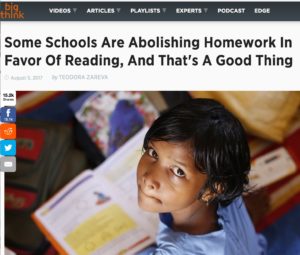K-12 Policy Reform August News
August news items and notes for the K-12 education reform topic.
• “The newest advantage of being rich in America? Higher grades
Escalating grade inflation at wealthy high schools is another blow to poor kids” (Hechinger Report, August 16, 2017)
Those enrolled in private and suburban public high schools are being awarded higher grades — critical in the competition for college admission — than their urban public school counterparts with no less talent or potential, new research shows.
• “How Free Eyeglasses Are Boosting Test Scores in Baltimore,” Politico, August 17, 2017)
Could the persistent gap in reading performance between poor students and wealthier ones be closed if they gave the poor students eyeglasses?
• “Exclusive: How Safe Is My Child at School? New Interactive Maps Allow NYC & LA Parents to Compare Classrooms,” (The74, June 7, 2017)
A recent poll of first-generation college students found that 1 in 4 did not feel safe in high school…What if there were a safe alternative across town, or even half a block away? Would families even know that?
• “Should Literacy Instruction Be a Constitutional Right?” (Education Week, August 15, 2017)
U.S. Constitution doesn’t say anything explicit about education, leaving it up to states… That’s why most litigation over school adequacy has been fought at the state level, rather than at the federal level.
• “Before You Study, Ask for Help: That’s one of several ways students can better prepare themselves for tests in the new school year,” (Wall Street Journal, August 15, 2017)
Students who excel at both classroom and standardized tests such as the SAT and ACT aren’t necessarily those who study longest. Instead, they study smart—planning ahead, quizzing themselves on the material and actively seeking out help when they don’t understand it.
• “Seeing Hope for Flagging Economy, West Virginia Revamps Vocational Track,” (New York Times, August 10, 2017
Simulated workplaces, overseen by teachers newly trained in important state industries like health, coal and even fracking, are now operating in schools across the state.
• “19 Is the New 60: Adults should stop stealing away the time kids need to play.” (Wall Street Journal, August 10, 2017)
In elementary school, a quarter of the boys and half the girls weren’t getting even a single hour of “moderate-to-vigorous activity” each day.
• “The Concentration of Poverty in American Schools,” (The Atlantic, February 19, 2016)
This systemic economic and racial isolation looms as a huge obstacle for efforts to make a quality education available to all American students.
• “In one state, students are ditching classrooms for jobs,” (The Hechinger Report, August 6, 2017)
Work-based learning programs are slowly gaining traction in Vermont and other states as schools consider ways to better prepare students for college and careers.
• “Demonizing School Choice Won’t Help Education,” (Bloomberg, August 1, 2017
We would like every kid in America to have the same kind of options we did to exit those failing institutions. And while we hate segregation, it’s hard for us to see how vouchers could make educational segregation worse today, given how extreme it already is in most major cities.
• “Some Schools Are Abolishing Homework In Favor Of Reading, And That’s A Good Thing,” (Big Think, August 5, 2017)
…research that shows that homework does not improve achievement for younger students, but time free from school type activities is important for their development.
• “Anaheim’s ‘trigger’ win shines light on dysfunctional system,” (Orange County Register, August 5, 2017)
Anaheim Elementary School Board trustees voted in late July to allow parents to convert the ill-performing Palm Lane Elementary School into a charter school. School officials have spent more than $800,000 in taxpayer money and two years battling mostly low-income parents over their effort to become the first Orange County school to use the so-called “parent trigger” law.
